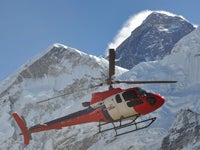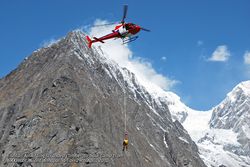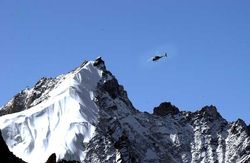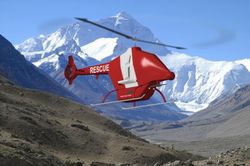
Followers of Everest know that rescues are difficult and sometimes impossible above base camp or 17,500'. In his book, Into Thin Air, Jon Krakauer details the daring rescue of climbers at the top of the Icefall at 19,800'.
Nepal pilot and army captain, KC Madan, became a hero with hisdaring rescue of Beck Weathers and Makalu Gau via a stripped downhelicopter, a B-2 Squirrel A-Star Ecuriel helicopter, that barely flewin the thin air of the Western Cwm.
In 14 years, things have changed.
Now a new service is underway that designers are confident canrescue climbers deep in the Western Cwm, well above 19,500'. While anexperiment this season, it has already proven to save lives on otherhigh peaks.
is training with ’srescue operations who have saved many lives in Europe. Air Zermatt isknown as an expert in conducting Human Sling Operations (a difficultaerial rescue maneuver involving dropping an expert mountain guide atan inaccessible point to lift stranded people using ropes).

The Fishtail approach has already been used this year on the highHimalayan peaks of Annapurna and Manaslu. Fishtail recently announced:
Fishtail Air & Air Zermatt’s team made a recordbreaking rescue on 29th April, 2010 using ‘human sling operation’, onMt. Annapurna I (8091m/26,545ft). Three Spanish climbers were evacuatedfrom 6900m by Fishtail Air’s AS 350 B3, using human sling operation.The climbers were stranded in the mountain due to bad weather for 36hours.
The rescue operation was carried out by Capt. Daniel Aufdenblattenfrom Air Zermatt, Switzerland, while Swiss Mountain Guide, RichardLenner hung on the sling and lifted the stranded climbers. The threeSpanish climbers were evacuated with the longline, one by one and flownto base camp at 4000 meter. This was the highest longline rescue inhistory.
Fishtail Air has been carrying out special rescue missions thisseason, together with Air Zermatt’s assistance, using it’s newlyacquired AS 350 B3. Recently the team had rescued 4 Korean Climbers and3 Nepalese Sherpas from 6,500m at Mt. Manaslu on 26th April.
Jamie McGuiness, of Project Himalaya and a Kathmandu residentattended an announcement event by Fishtail air earlier this year. Hespoke with the staff including pilots and was curious if they couldland the helicopter in the Western Cwm in addition to their longlineapproach.
Jamie told me that Fishtail are sure they can land at 21,0000 feetor 6400m, no problem. He raised the question if turning in flight inthe Western Cwm might be a problem, but nobody seemed to think thiswould be an issue. He also asked what was better, flat terrain forlanding – or a place with a drop off in front (for forward speed), i.e.the last flat bits before the Icefall drops off. While he didn’t get adefinitive answer, both seemed fine.
He said they did some filming around Ama Dablam (22,349) and saidhovering (no forward speed) for a shot of the climbers on the summitwas no problem. Jamie noted that Fishtail has permission to fly to23,000ft in Nepal and can LAND at 23,000ft but special permissionrequired. Jamie finally went on to say:
I did talk over the safety aspects of high rescues,obviously wind-visibility conditions have to be good. I specificallyquestioned them about air temp etc, and they might look into it, butthey seemed basically unconcerned and seem to have full faith in the B3.
Fishtail is welcome news because there have been other attempts and plans over the years

But as all things Everest, there was controversy and some doubtedthe actual landing but not the helicopter flight itself. Interestingly,in a post flight with National Geographic �����ԹϺ���, the pilot said he did not want tosee helicopters used for tourism and that a more powerful helicopterwould be needed for rescues.
Tourism is unthinkable. You'd need safety standardscomparable to passenger flights on an airliner. Personally, I'd like tosee the Tibet and Nepal governments make rules to ensure that touristflights never happen.

The helicopter, dubbed the Alpine Wasp was to be remotely-controlledat altitudes up to 30,000 feet, and be able to lower a lifeline thatclimbers can latch onto. However, they never got off the ground andwent into in mid 2008. Today the website for is in Russian and no news has been published in over a year.
But now that we have a viable helicopter rescue technique in theHimalaya, climbers have expressed concerns that Fishtails's newcapability might usher in an era of flight-seeing that disrupts themountain environment. Several times this season, helicopters havearrived at base camp appearing to be more tourist flights than medicalevacs.
Tim Rippel of Peak Freaks made this post once the B3 caused a stir at BC:
As a result a meeting was called today among leaders atthe HRA -Everest ER tent to engage in talks about what to do about it.The idea of bringing these helicopters into Nepal for high mountaintours and rescues comes with the potential for accidents. Tim says,”It's not like we have air traffic controllers up here” Fish Tail Air,a Swiss owned company has brought a second AS 350 B3 to Nepal, amulti-million dollar helicopter. One of them recently performed a longline rescue of a climber at 7000m on Annapurna. In order to affordthese high tech machines they need an ongoing revenue stream.
As a result, they have positioned themselves at Everest Base Campthis spring looking for climbers with deep pockets who can afford theluxury of a ride out to Kathmandu, check into a 5-Star hotel, oxygenateand fly back up for their summit push. I don't have the price yet butwe are looking into it. You can be sure it will be well over the 10kmark. Right now a helicopter lift out of Pheriche for sick climbers andtrekkers is 6k one way and about 8k one-way out of EBC. Theconsequences of this luxury is causing some concern in air safety.
Today the leaders talked about building a second landing pad forcivilians further back from the glacier keeping the air space clearfrom the HRA-Everest ER heli-pad location that is prepared each seasonas the glacier moves. It is closest to the teams and icefall. Right nowboth helicopters are sharing this space, noisy, dangerous and debrisgetting tossed around. Don't be surprised if there will be fly in toursoffered in the future complete with oxygen bottles for when you arrive,because you will need them!!!… and then what would you do if weatheror mechanical issues came into play? Be prepared to sleep on o's allnight at a price of $400US per hour plus shipping till things clear-yikes!!!
Tim was not far off as elite climber Simone Moro used the FishtailAir service to take his client back to Kathmandu then piloted the crafthimself back to base camp once his client ended his effort.The goodpeople at EverestER put it this way:
The other technological advance in base camp: theEurocopter B3. Powerful and fast, and certainly safer than other shipswe’ve landed in base camp in the past. But make no mistake, uncertainweather and wind combined with thin air and shifting/melting landingzones can’t be considered pedestrian travel, even for the biggestlatest heli. Our camp hosted an expedition leaders' meeting regardingwhat some see as the increasingly frivolous use of the helipad weconstructed for RESCUE purposes. (We’ve seen tourists landing on ourcarefully crafted rescue landing zone, jumping out to take photos, thentaking off again.
None of us can forget the several deadly crashes we’ve seen over thepast few years, and each landing grates on most of us … hence themeeting. All agreed that analogous to many things here, just becausewe can, doesn't mean we should, no matter how wealthy the client. Secondly, it's up to the expedition leaders, on this matter, to educateclients as to how things are done and what constitutes acceptablehelicopter use at 17,600ft. Some volunteered to contact the helioperators, especially the ones w/ the B3's, about funding a secondhelipad further down glacier…away from settlement at base camp. Ifsomeone wants to take the risk of landing at high altitude, at leastthey can do it without endangering all of us who live in the tentsbelow.
There have been multiple deadly helicopter crashes at Everest BaseCamp including 1997, 2003, 2005 and 2007. Even with the concerns, theservice is adding value today. Over the next few days, a body recoverywill take place on Lhotse supported from the ground by the team.
The Alpinist website has two excellent on Fishtail Air. Finally, note, that China currently does not allowhelicopter rescues or even flights to base camps of the 8000mmountains; obviously including Everest.
Overall this is a good advancement that will definitely save livesbut hopefully will not encourage unnecessary risks from climberscounting on a rescue anywhere on the mountain.
Climb On!
Alan
Arnette is a speaker, mountaineer and Alzheimer's Advocate. You can read more on his